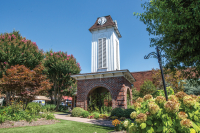Turning towards woodturning: Mike McKinney’s path to discovering his craft
By Andrew Dundas • Contributing Writer | Bowls in various stages of production scattered the workshop around Mike McKinney, piled onto tables and shelves besides a host of different woodworking equipment. At the center of it all sat the lathe, illuminated by studio lights and backed by a wall of hanging tools. Behind the lathe, Mike prepared his next piece for turning, answering questions about his craft with quiet-but-clear passion.
Between the lines tells the story: Waynesville woodworker carves into passion
When you are in the presence of the woodwork by Ben Grant, you find yourself captivated by the contours of his pieces.
Rare wood hunter unearths irresistible beauty in salvaged burl wood
 Stephen Metzger was like a kid in a candy shop as he clambered over a massive mound of behemoth tree trunks piled high in the wood salvage yard behind Moose Crossing, a woodworking studio on the outskirts of Waynesville.
Stephen Metzger was like a kid in a candy shop as he clambered over a massive mound of behemoth tree trunks piled high in the wood salvage yard behind Moose Crossing, a woodworking studio on the outskirts of Waynesville.
“Ashe, red oak, box elder, white oak, walnut, hard maple, sugar maple, sycamore,” Stephen said. “We’ve got a huge investment right here — huge.”
Turning through the years: Community invited to Carolina Wood Turning Company reunion
 The furniture manufacturer remembered as Carolina Wood Turning Company has been closed for more than 30 years, yet the smell of freshly cut wood and the sound of the steam whistle are still fresh in the minds of those who earned a living there.
The furniture manufacturer remembered as Carolina Wood Turning Company has been closed for more than 30 years, yet the smell of freshly cut wood and the sound of the steam whistle are still fresh in the minds of those who earned a living there.
The Bryson City business had many names throughout the years and made a number of different products, but its lifeblood was making furniture from Western North Carolina lumber. The company made wood pump tubing, tanners’ liquor logs and miscellaneous wood trimmings and solid bored colonial porch columns that can still be seen on older homes in Swain County.
Cutting through to your passion
 Standing in his basement workshop, furniture maker Roy DuVerger looks around the cluttered, dusty space. It may look like chaos to some, but to him, it’s the sign of a busy man doing what he loves.
Standing in his basement workshop, furniture maker Roy DuVerger looks around the cluttered, dusty space. It may look like chaos to some, but to him, it’s the sign of a busy man doing what he loves.
The rich history of an award-winning wood carver
 By Shannan Mashburn • SMN Intern
By Shannan Mashburn • SMN Intern
Wood carver Cliff Hannah is deeply rooted in Western North Carolina.
The internationally renowned artist is from Sandy Mush and has family ties to Cataloochee, the pioneer community in Haywood County that is now part of the Great Smoky Mountains National Park.
Turning new life into wood
Allen Davis’ office is cluttered with planks and blocks of wood in various sizes and a handful of circular saws — typical office supplies for a wood turner.
“I always wanted a wood shop,” said Davis, who crafts and sells wooden works in a small building up from his house on Foot Hill Lane in Waynesville.
For the last 15 years, Davis has earned his living as a wood turner, creating bowls, sinks, pens and urns. Different from other types of woodwork, woodturning is the process of shaping wood on a lathe, or rather, a machine that turns the material as a carver works with it.
Davis said he likes to work with wood “because it’s such a challenge.” Each piece must be cut precisely in order to fit perfectly together.
Different types of wood have different viscosities. Purple heart and ironwood are “hard as nails,” Davis said, and must be cut slowly. If split too quickly, the wood will warp and the individual pieces that make a bowl or urn will not fit together.
The majority — about 80 percent — of the wood he uses is scrap, and most of his works include stars or three-dimensional blocks.
Geometry is a large part of his work, Davis said, including the patterns he uses and how the pieces fit together.
“You are totally unlimited as far as what you can do with designs,” he said.
Davis uses 40 different species of tree. Among his materials are driftwood from Florida, California redwood, Louisiana swamp cypress and pecan, Mississippi tupelo or black gum, North Carolina dogwood and apple, and weathered South Carolina barnwood.
The wood sits in a kiln for six months where it dries out before it’s used.
Bowls are by far his most popular work. The base of an average bowl is 16 blocks around. Davis cuts the one- to two-inch trapezoidal pieces with one of his saws and uses tape to connect them in a circular shape. He uses similar, though more, blocks to form the upper layers of a bowl, creating a pattern. Davis then attaches it to a thick, round portion of wood that will later be molded into the bottom of the bowl.
Davis numbers and signs the bottom of each creation. The number corresponds to a detailed profile of each piece. Say someone purchased a large bowl for salad and would like smaller bowls to match, the customer can simply relay the number, and Davis will make a companion piece.
From passion to profession
Davis worked as a professional, heading two Florida corporations during his career. But in 1997, he retired and moved more permanently into his 10-acre Waynesville residence, which he purchased 30 years ago as a second home.
He also returned to his former passion — woodwork. He had some experience working with wood in high school but had not practiced since.
To brush up on his knowledge, Davis registered for a wood cabinet-making course at Haywood Community College but was more drawn to woodturning. And when the rippling effects of Sept. 11 lowered the value of his retirement portfolio, Davis needed something to supplement his income.
His pieces range from $30 to $1,000, and he sells more than 1,000 works every year.
“This is our bread and butter,” Davis said.
His woodturning business has allowed Davis and his wife, Diane, to keep their home in Florida and travel to various destinations around the world, including their upcoming trip to France.
“We do a lot of traveling,” Davis said. “This pays for a lot of really neat vacations.”
Davis and his wife also travel to craft and fine art shows throughout the year. However, he only displays his work at exhibitions that are judged or paid entry.
At other shows, “People aren’t coming to buy,” Davis said.
He said his target audience is “serious art collectors” — people willing to pay an admittance fee.
His work is also featured in 72 galleries and stores throughout the U.S., including Sabbath Day Woods Gallery in Canton, Its By Nature in Sylva, Jarrett House Gift Shop in Dillsboro, and Kitchen Décor and Textures in Waynesville.
During his spare time, Davis gives demonstrations on how to turn wood.
“A lot of my efforts are to teach kids,” he said.
He has hosted workshops for at-risk teens at Eckerd Youth Alternatives Camp in Hendersonville and for Big Brother/Big Sister of Haywood County.
Davis is also a member of the American Association of Woodturners, Carolina Mountain Woodturners, the American Craft Council and Southern Highland Craft Guild.
For more information on Allen Davis and his work, visit winchesterwoodworks.net.
Something to hold on to: Master furniture maker inspired by handmade revolution
John Gernandt loves the word tactile. It’s not so much the word, really, as the whole concept. People, he says, love to pet things. It is in our nature. We are, by default, a touchy species.
He is saying this as he sits on a low wooden stool, running his fingers along the pock-marked texture carved into the sides. See, he says, it’s tactile, human.
Gernandt is a master carpenter, a third-generation furniture maker, and the piece he’s sitting on is one of his own, on display in his downtown Waynesville gallery, Textures on Main.
His creations are dotted around the gallery, and though they’re all different, most are easy to pick out as being crafted by his hand. The workmanship is excellent and has built him a reputation in the world of custom furniture-making. His portfolio includes works done for millionaire clients, as well as some done for locals. He’s not an elitist in that sense, as evidenced by his belief that furniture – even art – should be touchable.
He’s a strong proponent of the handmade revolution, and speaks with passion about populating modern life with objects made by actual craftsmen. He counters what he sees as the myth that handmade or custom is necessarily more expensive.
“My furniture doesn’t cost a dime more than if you go to a nice furniture store, and it can’t, because that’s my market,” says Gernandt.
There is, he says, something to be said for having and using things that someone has poured time and thought and talent into.
“When you sit down at a table where there’s handmade dishes and glasses and chairs, it’s a good feeling,” he says. “And it’s heirloom furniture.”
And that’s what he’s in the business of building: heirloom furniture.
He has a workshop in the basement of his Main Street gallery where he uses only domestic woods to craft his works, 80 percent of which are commissions.
There are curving templates of every shape and size hanging on the walls of the workroom, which he proudly says are all what he calls human curves. They are all modeled after curves one might find on actual humans, none are made by protractors or compasses. “I think they’re just stale,” he says of such mechanical curves. And that’s part of what Gernandt says is appealing about his work. It’s human, tactile.
As an example, he points to a particular table back upstairs in the gallery. Its legs have a slight outward slant which, he says, came from the person who commissioned the piece. He had her lean forward as her husband traced the curve of her lean, and that is the curve of the table. There are examples of that everywhere, he says.
In terms of strict classifiers, his style is contemporary, and that is what he markets himself as. But he doesn’t see contemporary as a strict genre to which he must conform. He is adamant that contemporary is the culmination of all traditions that have come before, and he takes great pleasure in studying them then incorporating them into what he does today.
“I enjoy studying furniture history,” says Gernandt, pointing out a King Louis ankle wrap on a cabinet standing against the wall. That’s part of the fun, incorporating elements of history into new creations.
Gernandt’s own personal furniture-making history started early, age 9 to be precise. His grandfather was a furniture maker, and he loved working with the older man. As a young boy, he approached him with the notion that he, too, would like to make furniture for a living. His grandfather considered and pointed the young Gernandt to an unsanded chair.
“’There’s a chair down there, sand that,’” he said. “‘It’ll take you eight hours a day for five or six days.’” And when he completed the job, his grandfather awarded his stamp of approval, conceding that maybe his grandson had what it took to make it a career.
He did do a stint away from the craft for a while, getting a degree in education before returning to furniture artistry for good in his twenties.
Then he and his wife Suzanne, a textile artist, moved to Western North Carolina with their children because, he says, it’s at the heart of craftsman culture in America.
And business has been good for them, though, of course, not perfect.
He is hopeful that there will always be a market for quality crafted pieces like his, pieces that have a story and a history.
He’s very excited about the idea of apprenticeships to keep the craft alive, and hopes that what he’s able to pass on to future furniture makers is the idea that what makes them important and unique is their creativity.
He’s aware that, in terms of cost, he can’t compete with flat-pack factory furniture, but there is something more valuable, he says, about creativity and craft.
“I think people are starting to understand the importance of creativity in their life,” says Gernandt. “You feel better about your life, and there’s value in that. There’s real value in that.”
To see more of the work of John and Suzanne Gernandt, visit www.texturesonmain.com.









